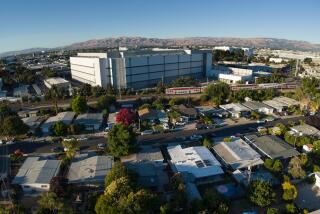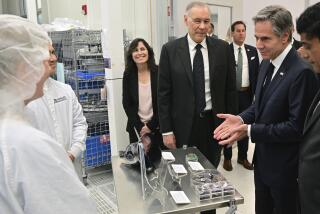UCSD Supercomputer Goes Into Action : New Computing Center Will Link Scientists Around the Nation
- Share via
LA JOLLA — The $14-million Cray supercomputer that was installed in the new UC San Diego Center for Supercomputing this week and unveiled Thursday is a creature that demands comforts.
The supercomputer was transported gently from its birthplace at Cray Research Inc. in Chippewa Falls, Wis., to San Diego in a specially designed moving van with a hand-picked driver who followed a carefully selected, bump-free route.
At UCSD the supercomputer took up residence in a state-of-the-art, $7.5-million building that is nearing completion.
The computer dominates the building’s core and enjoys a perfect computer environment, with precisely monitored temperatures and humidity levels, and a complex air filtering system.
The bright red and black computer will be linked to an expensive refrigeration system that dissipates the heat generated as it whips through nearly one billion calculations each second. Once the Cray’s companion computers are hooked up, the Cray supercomputer will store an astonishing 10 billion bits of information.
In return for that care and pampering, however, the Cray will put in long hours, according to San Diego Supercomputer Center Director Sidney Karin.
“When you’ve got something that costs $14 million, you don’t turn if off on Saturday and Sunday,” Karin said. “We’re going to run this machine 24 hours a day, 7 days a week.”
While the supercomputer will keep cool with its own refrigeration system, it will be a different story for those who work in the center. California law generally prohibits the use of air conditioning in newer university buildings, so the offices at the center will depend on two old-fashioned but reliable methods for cooling--ceiling fans and windows that open.
“This is probably the first building built in the last 100 years in San Diego with ceiling fans,” said building architect Robert Mosher.
The supercomputer center will run on a budget of $100 million for its first five years, with a staff that will grow to 62 full-time employees.
Mayor Roger Hedgecock, speaking at a press conference in the center, credited the supercomputer facility with “catapulting San Diego into the front ranks of the cities of the world.”
“This is one big step for San Diego,” acknowledged UCSD Chancellor Richard C. Atkinson. “But there is also a clear recognition that this is a very important day for the nation.”
Atkinson was referring to a complex communications web that will connect the Cray supercomputer with universities and research facilities across the country.
The UCSD center will be used by as many as 500 scientists at a time from universities as far away as Hawaii and Maryland. By mid-1986, a satellite and telephone line system will link the supercomputer to nearly 10,000 scientists, engineers and graduate students, Karin said.
The center, one of three funded by the National Science Foundation, will focus its research in a variety of areas, including molecular biology, astrophysics, chemistry, physics and the earth sciences.
Local scientists also have lined up with interesting proposals for the Cray supercomputer. One group wants to use the computer’s astonishing speed to help design buildings that will survive earthquakes and strong winds. Another group wants to use the supercomputer’s advanced graphics system to observe what happens when the various components of molecules are juggled around.
A third group plans to use the computer’s computing speed and vast memory to improve man’s ability to predict long-range weather patterns.
NSF guidelines also call for 10% of the supercomputer’s use to be dedicated to industrial research, according to Robert Randall, manager of resource development. The center probably will announce its first industrial user in the next few weeks, Randall said.






